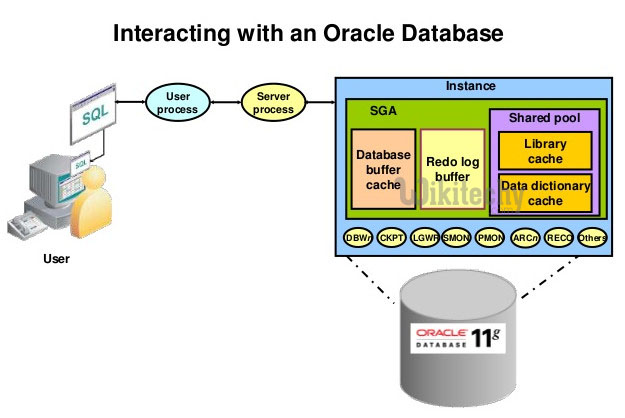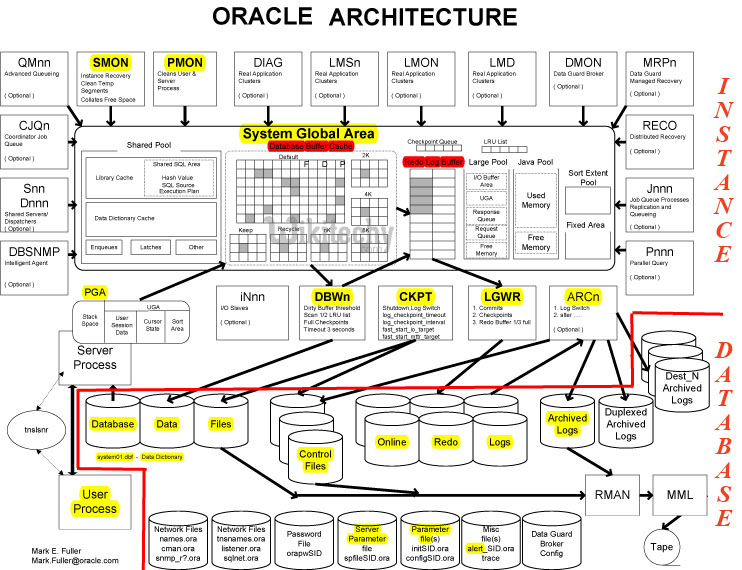Oracle Introduction - oracle tutorial - sql tutorial
Oracle Database Access Flow

- An Oracle database is a collection of data treated as a unit. The purpose of a database is to store and retrieve related information.
- A database server is the key to solving the problems of information management.
- In general, a server will reliably manage a large amount of data in a multiuser environment so that many users can concurrently access the same data.
- All the above is accomplished while delivering high performance.
- A database server will also prevent unauthorized access and provides efficient solutions for failure recovery.
- Oracle Database is the first database designed for enterprise grid computing, the most flexible and cost effective way to manage information and applications.
- Enterprise grid computing will create large pools of industry-standard, modular storage and servers.
- With this architecture, each new system can be rapidly provisioned from the pool of components.
- There is no need for peak workloads, because capacity can be easily added or reallocated from the resource pools as needed.
- The database has logical structures and physical structures. Because the physical and logical structures are separate, the physical storage of data can be managed without affecting the access to logical storage structures.
Oracle Architecture

Founding of Oracle:
- Larry Ellison and two friends and former co-workers, Bob Miner and Ed Oates, started a consultancy called Software Development Laboratories (SDL) in 1977. SDL developed the original version of the Oracle software.

Overview of Oracle Grid Architecture:
- The Oracle grid architecture pools large numbers of servers, storage, and networks into a flexible, on-demand computing resource for enterprise computing needs.
- The grid computing infrastructure continually analyzes demand for resources and adjusts supply accordingly.
- Grid computing uses sophisticated workload management that makes it possible for applications to share resources across many servers.
- Data processing capacity can be added or removed on demand, and resources within a location can be dynamically provisioned. Web services can quickly integrate applications to create new business processes.
oracle tutorial , sql tutorial , sql , pl sql tutorial , oracle , pl sql , plsql
Difference between a cluster and a grid
- Clustering is one technology used to create a grid infrastructure. Simple clusters have static resources for specific applications by specific owners.
- Grids, which can consist of multiple clusters, are dynamic resource pools shareable among many different applications and users.
- A grid does not assume that all servers in the grid are running the same set of applications.
- Applications can be scheduled and migrated across servers in the grid. Grids share resources from and among independent system owners.
- At the highest level, the idea of grid computing is computing as a utility. In other words, you should not care where your data resides, or what computer processes your request.
- We should be able to request information or computation and have it delivered - as much as you want, and whenever you want.
- This is analogous to the way electric utilities work, in that you don't know where the generator is, or how the electric grid is wired, you just ask for electricity, and you get it.
- The goal is to make computing a utility, a commodity, and ubiquitous. Hence the name, The Grid. This view of utility computing is, of course, a "client side" view.
- From the "server side", or behind the scenes, the grid is about resource allocation, information sharing, and high availability.
- Resource allocation ensures that all those that need or request resources are getting what they need, that resources are not standing idle while requests are going unserviced.
- Information sharing makes sure that the information users and applications need is available where and when it is needed. High availability features guarantee all the data and computation is always there, just like a utility company always provides electric power.
Responsibilities and Role of Database Administrators
- Each database requires at least one database administrator (DBA). An Oracle Database system can be large and can have many users.
- Therefore, database administration is sometimes not a one-person job, but a job for a group of DBAs who share responsibility.
- A database administrator's responsibilities can include the following tasks:
- Installing and upgrading the Oracle Database server and application tools
- Allocating system storage and planning future storage requirements for the database system
- Creating primary database storage structures (tablespaces) after application developers have designed an application
- Creating primary objects (tables, views, indexes) once application developers have designed an application
- Modifying the database structure, as necessary, from information given by application developers
- Enrolling users and maintaining system security
- Ensuring compliance with Oracle license agreements
- Controlling and monitoring user access to the database
- Monitoring and optimizing the performance of the database
- Planning for backup and recovery of database information
- Maintaining archived data on tape
- Backing up and restoring the database
- Contacting Oracle for technical support
